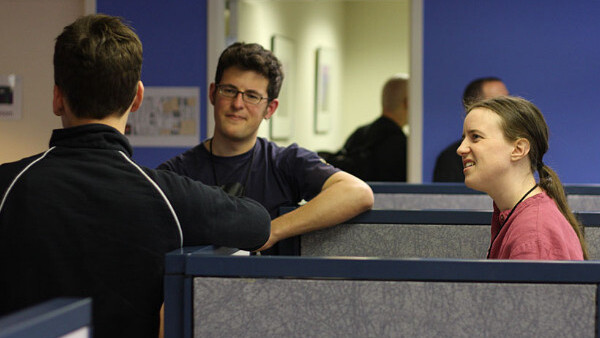
 For many years it seemed that our online lives were quite disparate from our work lives. Web services such as Amazon and eBay grew increasingly sophisticated whereas in many offices we were stuck with applications which were out-of-date before they were even rolled out. Well – the times they are a’changin. Corporate applications are learning from web applications and users are expecting increasing sophistication in our work environments.
For many years it seemed that our online lives were quite disparate from our work lives. Web services such as Amazon and eBay grew increasingly sophisticated whereas in many offices we were stuck with applications which were out-of-date before they were even rolled out. Well – the times they are a’changin. Corporate applications are learning from web applications and users are expecting increasing sophistication in our work environments.
The growing user base of social media suggests that corporate environments won’t be far behind. Already disruptive innovators (Yammer, SocialText, Podio and a host of others) are carving out a market niche. Established players are sure to follow, particularly vendors of corporate software who have large corporate user bases and a vested interest in not losing eyeballs. So – what should these vendors be thinking about?
1. Finding people in large organisations is very very hard
At its core, creating an organisation of people is about the sum being more than the parts – taking advantage of the fact the people working together can achieve more than people working alone. In any organisation bigger than about 100 people there will be colleagues who have not met and this means the organisation is not making best use of its collective of people.
The challenge is this: how does Joe – based in Vancouver and interested in server technology and snow skiing find Amanda – just joined the Toronto office with experience in deploying servers at a ski manufacturer? The killer app for an enterprise social network has to be some sort of “people finder” – a search function which allows people to look across a series of dimensions to identify colleagues with shared interest. LinkedIn’s people finder is a good design pattern for consideration.
Inside your corporate walls, dimensions of interest may include any of location, job title / role (current and former), division, clients (current and former), projects (current and former), a CV, a pen picture, a “things to contact me about” blurb on their profile, content from status updates, broadcast messages, etc.
2. Creating incidental links
A search for someone is an explicit transaction, something that requires a user to initiate. The real silver bullet for this type of software would be creating and raising incidental links. If you post a status along the lines of “heading to Acme Corp for a meeting” the software could show up a list of colleagues which match “Acme Corp” as former clients, employers, etc.
Think of it like Facebook’s “friends you may know” but focused on what content you’re working with rather than just looking for overlapping circles of friends. The intention is to recreate open-plan desk style eavesdropping, only across your entire enterprise.
3. Taking advantage of HR data without taking advantage of employees
Organisations have all sorts of data on their HR systems. In many cases, a basic profile could probably be created by drawing together some of this data into a Facebook / LinkedIn style profile. Some of this would be really useful on a profile (e.g. former employers), some would be really inappropriate (next of kin, address). It will be necessary to evaluate both benefit of surfacing this information and the privacy implications of doing so.
I imagine that the data policies we all sign up on joining an organisation will need to be updated to keep pace with this type of technology. These updates should be driven not only by the designers’ intentions but also by what the employers / users deem necessary and desirable. Imposing policy rarely, if ever, drives real cultural change in an organisation.
4. Surfacing transactional data
There’s one thing Facebook, LinkedIn and even Yammer can’t (or shouldn’t) access for most of us – the work we do every day. Within the corporate intranet, surfacing some of this data could be really powerful. Placing it alongside the social network features contextualises work alongside the people that we work with.
In my company (a consulting firm) we use a bespoke web app that surfaces key project, resourcing and meeting info onto my desktop. Ordinarily this would be, well, ordinary – but the app has social networking elements; alongside the transactional info I can access contact cards, profiles, activity streams and the like. In time, colleagues may be able to “comment” on relevant aspects of my work. The app blends my transactional work with my water cooler conversations.
Strangely, Facebook Beacon providing early sight of this thinking. It blended social networking features with transactional data. Blippy is along the same vein.
5. Integrating communications
E-mail and IM are reasonably commonplace in corporate environments these days. Enterprise social networks may introduce the status message, the message wall (Facebook), the broadcast message (Twitter), comment conversations, etc. There can be no doubt that employees talking to each more is beneficial – but is there such a thing as too much?
The challenge is how to make multi-modal communications integrated into the work environment without making it consume every moment of every day – a problem some of us are already having with just e-mail! The most important design consideration is to ensure that message sources are not left as disparate streams of information. E-mail, IM, etc. needs to be brought together in a unified inbox similar to an activity stream of system activity.
6. How do people build networks?
On Facebook you have friends. On LinkedIn you have a network of connections. On MySpace you have friends. And on all of these sites access to your “inner circle” is by invitation with no censure for saying no.
What do you call your “inner circle” of colleagues within your own organisation? How do you control who is allowed into the circle and who isn’t? Yammer’s approach is a Twitter style “follower model” whereas friendfeed has a privacy model allowing you to control who follows you.
Frankly, there’s no right or wrong answer. There may be design considerations relevant to the type of work environment – for example, in a project type environment you may want members of the same project teams to automatically become part of each others’ network. How you design your model will be driven by the culture of your organisation and, more importantly, what culture you would like the service to drive within the organisation.
Get the TNW newsletter
Get the most important tech news in your inbox each week.




